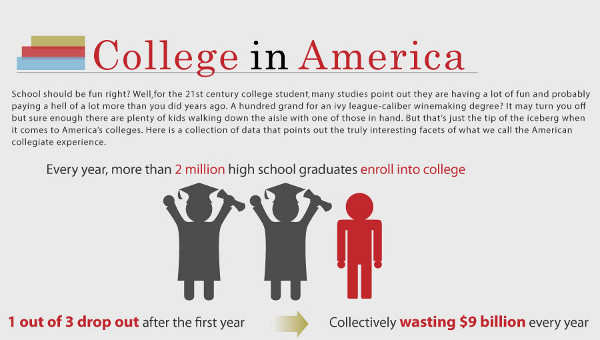What It Shows
Presented and discussed at FastCompany, the infographic gives a breakdown of statistics designed to encourage a person to question the value of going to college in America.
Why It’s Good
The visuals are well done and support the stats-based infographic. That’s all I’m prepared to say about what’s good.
What It’s Missing
Intelligence. This is one of the most ironically dumb infographics I’ve seen in a while. There are so many flaws it’s hard to know where to begin. I guess I’ll go in order.
That 1/3 of college students drop out in their first year isn’t a waste of 9 billion. At minimum, they probably learned something – if nothing else, that college isn’t right for them. It’s something potentially worth testing. How is the 9 billion spent so that it’s wasted? Funding the college? Any area that requires training has people giving up early on. It’s not exclusive to college.
Comparing the 4 years of room and board at Sarah Lawrence College to buying a Ferrari is moronic, unless the idea is that you’ll be living out of the car, in which case, you should probably find something roomier than a Ferrari. It’s called food and a place to stay, and the costs exist whether you go to college or not.
The infographic quotes figures of time spent partying, ignoring the likelihood that it’s largely an age issue. Young people of college age tend to party whether they’re in college or not. Yes, being in a building filled with people about your age makes socializing easier, but that’s not the point. It’s also hard to believe that, including classes, students spend a mere 8 hours a week studying. If it’s meant to indicate time spent at home studying apart from classes, then it’s misleading to put it in the context of the value of a college education.
Then the specific classes criticism. I wonder what the creators of this infographic would consider degrees worth paying for. I’m going to go out on a limb and guess “Business”. I wonder if they would disparage American Studies as readily as Canadian Studies.
I’d like an explanation as to why delaying buying a house and having children is so horrific a thing to do, in the infographic.
$5.5 billion is spent on alcohol each year. Considering there are 17.3 million college students, if an average drink price was let’s say $3 (taking into account cheap bulk and also expensive club drinks that can be more than double that figure per drink), that works out to two drinks per week per college student. Big deal.
Finally, the biggest problem of all is the fact that the arguments for supposed value of the college degree do not touch on the intrinsic value of the knowledge gained and the practice in learning and critical thinking. I know the type of person that buys into this kind of argument, and have dealt with my fair share of people who can’t see the value of a degree beyond the money it provides. I knew one girl that went to college just because she knew people who went to college would be making lots of money, so her goal was to find a husband by the time her college experience was over. Sick people out there.
This infographic can be found at Online Colleges and Universities (good job…) here.
